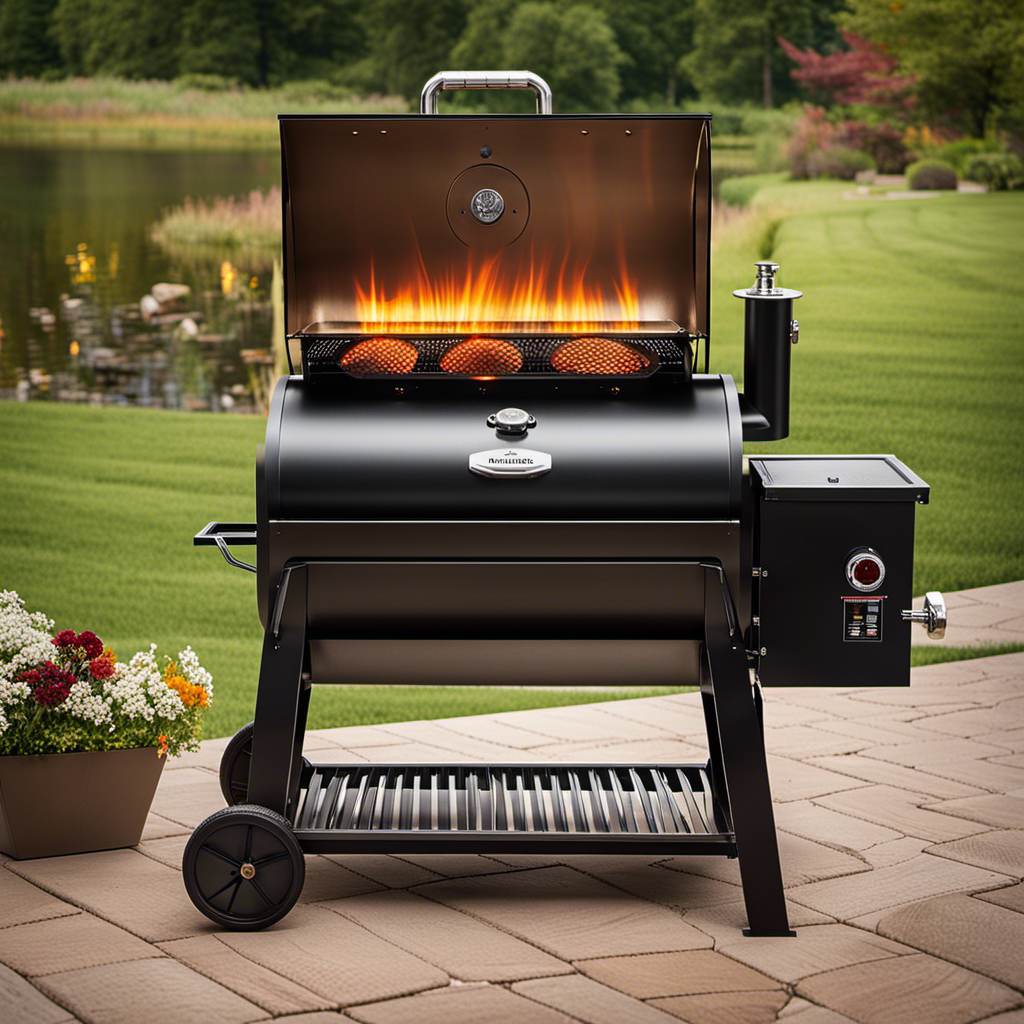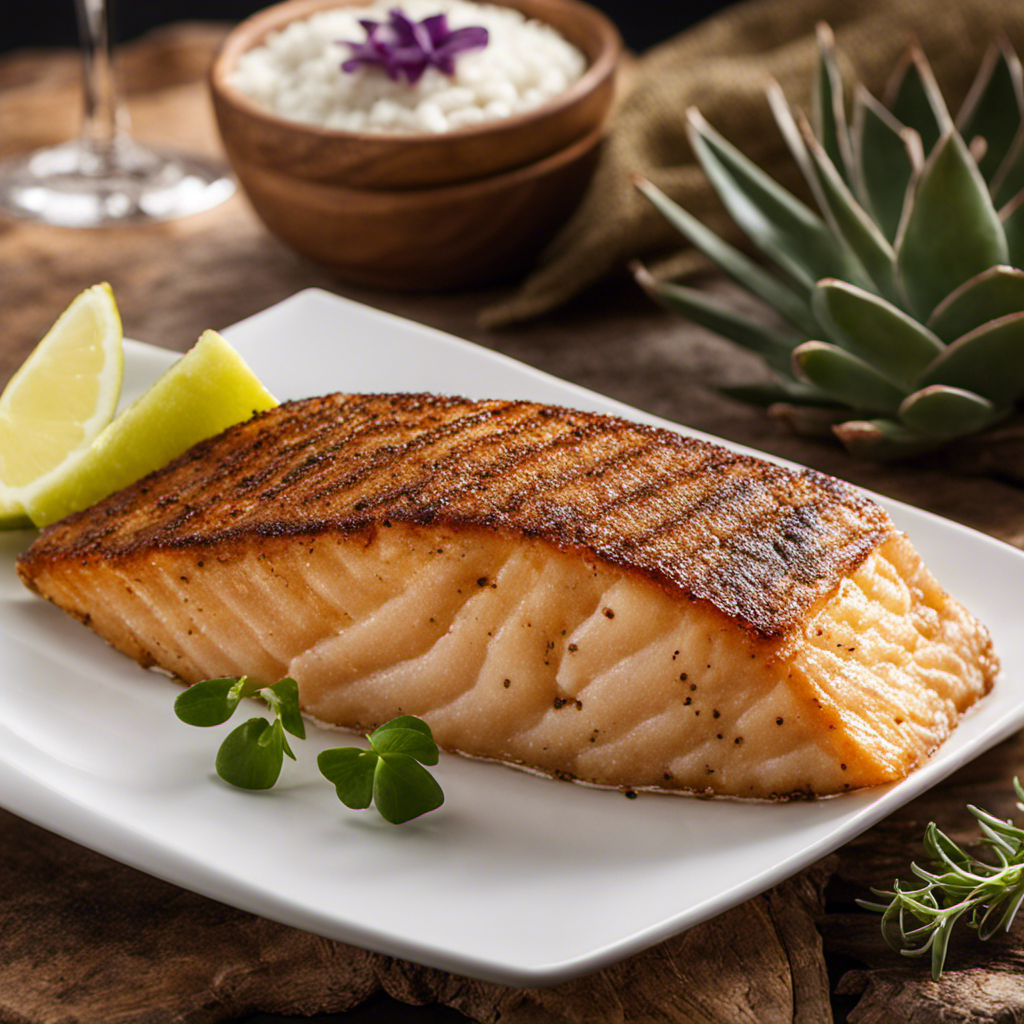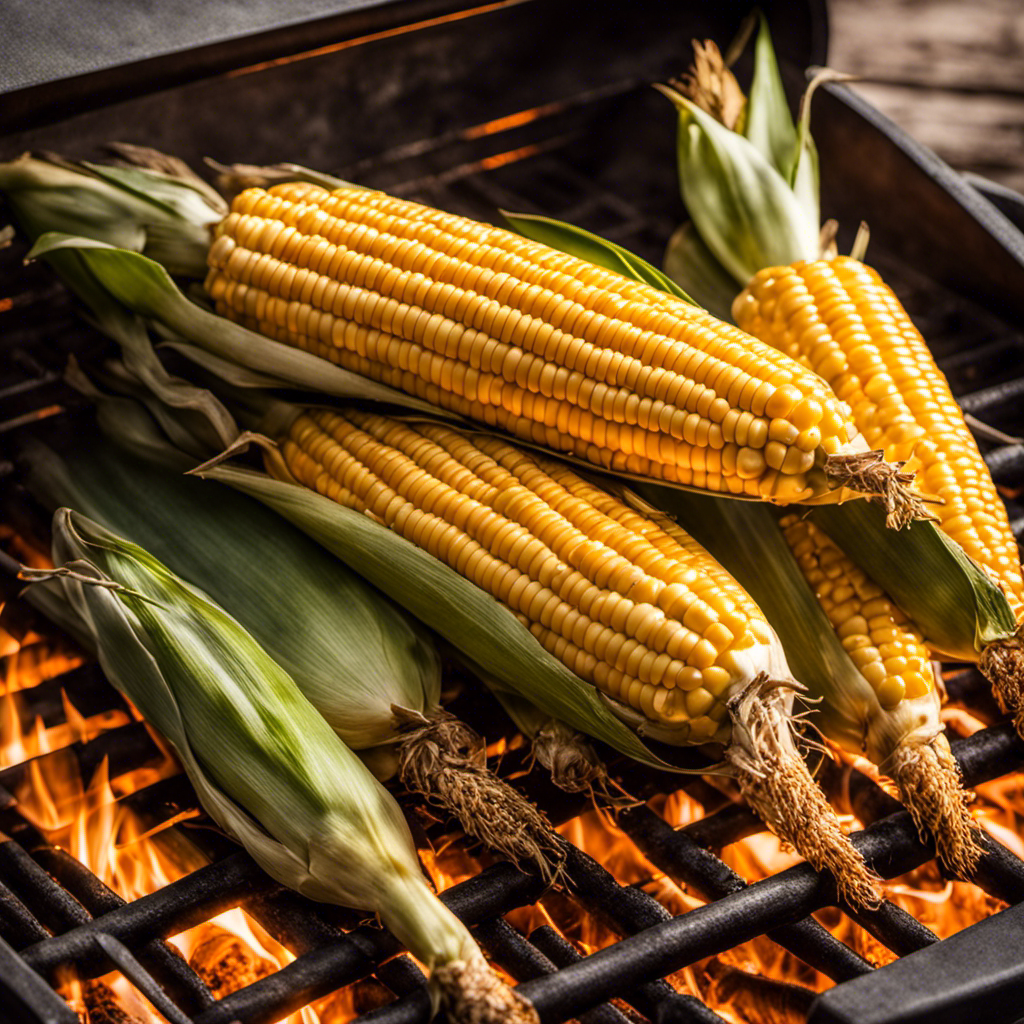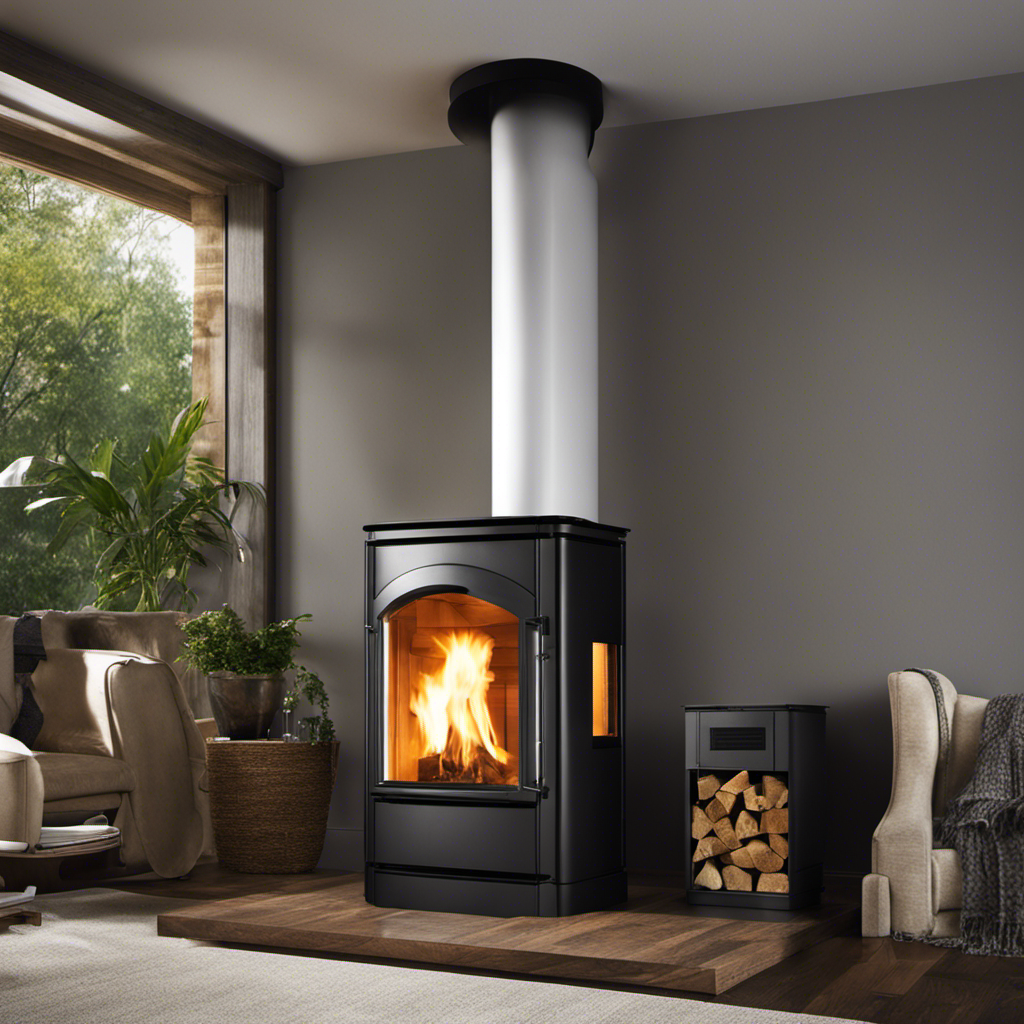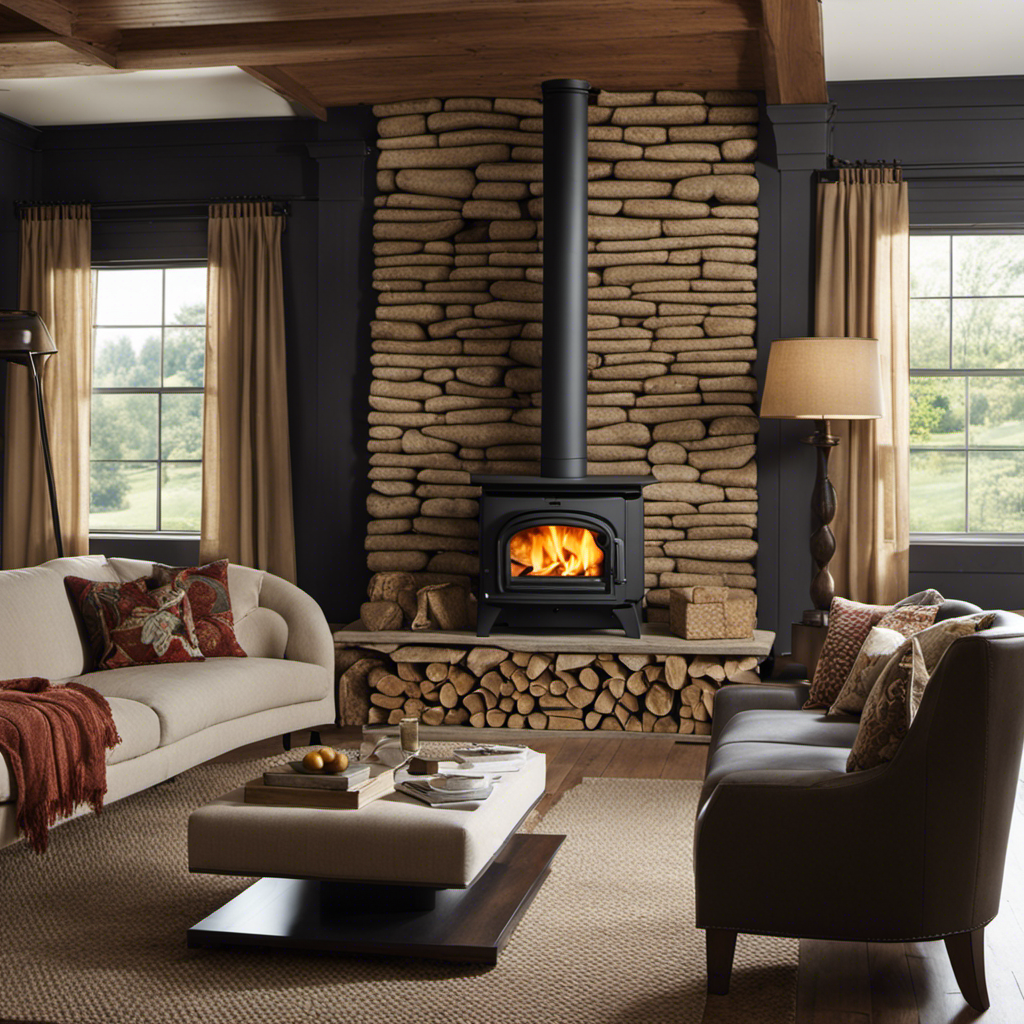I’ve always been intrigued by how wood pellet grills operate. Were you aware that these cutting-edge cooking appliances are capable of delivering steady, smoky tastes with minimal effort?
In fact, they have gained popularity in recent years, with sales increasing by 20% annually. So, how do wood pellet grills work?
In this article, I will delve into the intricate mechanisms behind these grills and explain how they create delicious meals infused with that irresistible wood-fired taste.
Key Takeaways
- Wood pellet grills use hardwood pellets as fuel and offer precise temperature control.
- The hopper stores and feeds pellets into the auger system, ensuring a steady supply for consistent temperature and smoke production.
- Wood pellet grills can have electric or hot rod igniters for reliable and quick lighting capabilities.
- They utilize convection cooking for even heat circulation and faster, more consistent cooking.
The Basics of Wood Pellet Grills
So, let’s start by explaining how wood pellet grills work. Understanding the different types of wood pellets available is key to using a wood pellet grill effectively. These grills are unique in that they use hardwood pellets as fuel instead of charcoal or gas. The pellets are made from compressed sawdust and contain no additives or fillers. They come in various flavors such as hickory, mesquite, apple, and cherry, which can add a distinct smoky flavor to your food.
Exploring the benefits of using a wood pellet grill over other types of grills, you’ll find that they offer precise temperature control, even heat distribution, and the ability to infuse your food with delicious smoky flavors.
Now let’s delve into understanding the pellet hopper and auger system without further ado.
Understanding the Pellet Hopper and Auger System
When it comes to wood pellet grills, understanding the pellet hopper and auger system is crucial.
The hopper serves as both storage and feeding mechanism for the pellets, ensuring a continuous supply of fuel during the cooking process.
The auger, on the other hand, plays a vital role in transporting the pellets from the hopper to the fire pot, where they are burned to generate heat.
This efficient system allows for precise temperature control and even heat distribution throughout the grill, resulting in perfectly cooked meals every time.
Hopper: Storage and Feeding
To use a wood pellet grill, you’ll need to understand how the hopper works for storage and feeding. The hopper is an essential component that holds the wood pellets, which are the fuel source for the grill. Here’s how it works:
-
Pellet Storage: The hopper is designed to store a large quantity of pellets, typically ranging from 10 to 30 pounds, depending on the size of the grill. This ensures that you have enough fuel for extended cooking sessions without constantly refilling.
-
Hopper Design: The hopper is usually located on the side or back of the grill and is equipped with a lid or cover to protect the pellets from moisture and other elements. It also has an opening at the bottom where the pellets can be fed into the auger system.
-
Feeding Mechanism: When you start your wood pellet grill, it automatically feeds pellets from the hopper into the auger system through gravity or with the help of an electric motor. This continuous feeding process ensures a steady supply of pellets to maintain consistent temperature and smoke production.
Understanding how the hopper functions sets us up perfectly to dive into another crucial aspect of wood pellet grills – the auger system responsible for pellet transportation.
Auger: Pellet Transportation
The auger in a wood pellet grill is responsible for transporting the pellets from the hopper to the fire pot. This crucial component plays a significant role in ensuring pellet transportation efficiency, which directly impacts the performance of the grill.
To maintain optimal efficiency, it’s important to regularly clean and inspect the auger for any signs of wear or blockages. Start by disconnecting power and removing any remaining pellets from the hopper. Carefully detach the auger from its housing and clean it thoroughly using a brush or cloth. Inspect for any damaged or worn parts and replace them if necessary. Additionally, lubricating the auger with food-grade oil can help reduce friction and ensure smooth operation.
By properly maintaining your auger, you can ensure efficient pellet transportation and maximize your wood pellet grill’s performance.
With efficient pellet transportation ensured by a well-maintained auger system, we now move on to discussing another critical aspect of wood pellet grills: efficient heat distribution throughout the cooking chamber.
System: Efficient Heat Distribution
To ensure efficient heat distribution in your cooking chamber, it’s important to understand how the system works.
Wood pellet grills are designed with precision to achieve optimal temperature control and even heat distribution. The key component of this system is the combustion fan, which controls the airflow inside the grill. This fan helps distribute the heat generated by burning wood pellets evenly throughout the chamber, ensuring that every part of your food is cooked consistently.
Additionally, these grills often have a heat diffuser or baffle plate that further aids in distributing heat evenly across the cooking surface. By utilizing this well-designed system, you can enjoy perfectly cooked meals with no hot or cold spots on your grill.
Now let’s delve into how the ignition process works without any delay.
How the Ignition Process Works
When it comes to the ignition process in wood pellet grills, there are different types of mechanisms that can be used.
One common type is an electric ignition system, which uses a hot rod or igniter to ignite the pellets.
Another option is a manual ignition system, where you use a flame source like a torch to light the pellets.
In terms of heating temperature control, most wood pellet grills have a digital controller that allows you to set and maintain your desired cooking temperature with precision.
Additionally, safety features such as automatic shut-off and fire detection systems are often implemented to ensure safe operation of the grill.
Ignition Mechanism Types
Choose between two types of ignition mechanisms for wood pellet grills: hot rod or electric igniters.
The ignition mechanism is an essential component of a wood pellet grill, as it initiates the combustion process that generates heat for cooking.
The hot rod igniter consists of a metal rod that heats up when electricity passes through it. It is commonly used in most wood pellet grills and offers reliable and consistent ignition performance.
On the other hand, electric igniters use an electric current to create sparks and ignite the pellets. While they can be more challenging to troubleshoot if any issues arise, they provide quick and easy lighting capabilities.
Now let’s move on to heating temperature control, where you can fine-tune your grilling experience without any hassle.
Heating Temperature Control
The temperature control on wood pellet grills allows you to adjust the heat levels for precise cooking. With this feature, you can easily achieve the perfect temperature for searing a steak or slow-smoking a brisket. The heating efficiency of wood pellet grills is unparalleled, thanks to their innovative design. Here’s how it works:
-
Precise Temperature Regulation: Wood pellet grills have a digital controller that allows you to set your desired temperature with accuracy. This ensures consistent and even heat distribution throughout the cooking chamber.
-
Automatic Auger System: These grills use an automated auger system to feed wood pellets into the fire pot at a steady rate. This not only maintains optimal heating efficiency but also adds a smoky flavor to your food.
-
Convection Cooking: Wood pellet grills utilize convection cooking, which circulates hot air evenly around the food. This results in faster and more efficient cooking, reducing overall cooking time while preserving moisture and tenderness.
With such advanced temperature control capabilities and heating efficiency, wood pellet grills are ideal for achieving perfectly cooked meals every time.
When it comes to safety features implemented…
Safety Features Implemented
One of the safety features implemented in these grills is an automatic shutdown system that activates if there is a sudden temperature spike or if the grill runs out of pellets. This feature is crucial in ensuring safety precautions and fire prevention measures are in place while using the wood pellet grill. The automatic shutdown system works by monitoring the temperature inside the grill and immediately shutting it down if it exceeds a certain threshold. Additionally, it also detects when the pellet supply is depleted and shuts down to prevent any potential hazards. These safety measures provide peace of mind to users, knowing that their grilling experience is not only delicious but also safe.
| Safety Features |
|---|
| Automatic shutdown system |
| Temperature spike detection |
| Pellet depletion detection |
Transitioning into controlling temperature with the digital controller, another essential aspect of wood pellet grills…
Controlling Temperature With the Digital Controller
Controlling the temperature on a wood pellet grill is simple with the digital controller. With its advanced capabilities, you can easily set and maintain the desired temperature for your cooking needs. The digital controller allows you to precisely control the temperature, ensuring consistency throughout the cooking process.
One of the key advantages of using a digital controller is its ability to maintain a consistent temperature. This is crucial for achieving perfectly cooked dishes every time. Whether you’re smoking meat low and slow or searing steaks at high heat, the digital controller ensures that the temperature remains steady, eliminating any guesswork.
Now let’s delve into how the fan and airflow play a vital role in cooking without skipping a beat.
The Role of the Fan and Airflow in Cooking
After learning about temperature control in wood pellet grills, let’s dive into the role of the fan and airflow in cooking.
The fan function plays a crucial role in maintaining consistent temperatures throughout the cooking process. Here are four key points to understand:
-
Enhanced combustion: The fan helps supply oxygen to the fire pot, ensuring efficient fuel burn and consistent heat production.
-
Even heat distribution: By circulating air within the grill, the fan ensures that hot air is evenly distributed across the cooking surface, preventing hot spots and cold zones.
-
Smoke circulation: The fan also aids in spreading smoke throughout the cooking chamber, creating that delicious smoky flavor we all love.
-
Airflow control: Adjusting the speed of the fan allows for precise temperature regulation, giving you full control over your cooking experience.
As we explore further into wood pellet grills’ functionalities, it’s essential to understand how drip trays and grease management contribute to an enjoyable grilling experience without compromising on cleanliness or flavor.
The Importance of the Drip Tray and Grease Management
The drip tray and grease management play a crucial role in keeping the grill clean and preventing flare-ups. Proper maintenance of the drip tray is essential to ensure its effectiveness. After each use, I recommend removing the drip tray and cleaning it thoroughly with warm soapy water to remove any accumulated grease or food particles. It’s important to check for any signs of damage or clogging in the tray and replace it if necessary.
Additionally, there are different options for grease disposal. Some grills have a removable container that can be easily emptied, while others require you to manually dispose of the grease. Regardless of the method, it’s important to dispose of the grease properly and according to local regulations.
When it comes to exploring the smoke production mechanism, we need to understand how wood pellets are used as fuel in these grills.
Exploring the Smoke Production Mechanism
When it comes to understanding the smoke production mechanism in wood pellet grills, there are a few key points to consider.
Firstly, combustion and airflow play a crucial role in generating smoke. The controlled airflow allows for efficient combustion of the wood pellets, resulting in the release of flavorful smoke.
Additionally, understanding the process of wood pellet combustion is essential as it directly impacts the quantity and quality of smoke produced.
Lastly, the smoke generation process involves various factors such as temperature, moisture content, and type of wood pellets used.
Combustion and Airflow
To ensure proper combustion and airflow in a wood pellet grill, you’ll want to adjust the damper accordingly. Wood pellet grills are designed with precision to maximize efficiency and enhance the cooking experience.
Here are some key points about wood pellet grill construction and the advantages they offer:
-
Construction:
-
Made from high-quality materials such as stainless steel or cast iron.
-
Insulated body helps retain heat for consistent cooking temperatures.
-
Advantages of Wood Pellet Grills:
-
Versatility: Ability to grill, smoke, bake, roast, and even braise your food.
-
Ease of Use: Automated temperature control systems make it simple for anyone to operate.
Understanding how these grills are constructed allows us to appreciate their many advantages. Now let’s delve into the fascinating world of wood pellet combustion without skipping a beat.
Wood Pellet Combustion
Adjust the damper accordingly to ensure proper combustion and airflow in your wood pellet grill. Wood pellet combustion is a crucial aspect of grilling, as it determines the heat produced and the amount of smoke generated. Understanding how wood pellets burn can help you achieve the perfect grilling results.
When ignited, wood pellets release both volatile gases and solid carbon. The volatile gases undergo combustion, producing heat, while the solid carbon forms charcoal that continues to burn slowly. This process allows for consistent and controlled heat output in a wood pellet grill.
Additionally, the combustion produces smoke, which adds flavor to your food. By adjusting the damper and controlling airflow, you can regulate the intensity of combustion and smoke generation in your grill.
Transitioning into the subsequent section about the ‘smoke generation process,’ we will explore how different factors influence the production of flavorful smoke during grilling sessions without explicitly stating a ‘step.’
Smoke Generation Process
Understanding the factors that influence smoke generation during grilling can help you achieve a more flavorful and aromatic result.
When it comes to creating that delicious smoke flavor, there are a few key elements at play:
-
Wood pellet quality: The type and quality of wood pellets directly affect the amount and intensity of smoke produced. Different woods impart different flavors, so choose your pellets wisely.
-
Temperature control: Maintaining a consistent temperature is crucial for achieving optimal smoke production. Too low of a temperature may result in insufficient smoke, while too high can lead to excessive burning and bitter flavors.
-
Airflow management: Proper airflow is essential for efficient combustion and smoke generation. Adjusting the ventilation controls on your grill allows you to fine-tune the amount of smoky goodness produced.
By understanding these factors, you can harness the power of pellet combustion to create mouthwatering dishes with rich smoke flavors.
Now let’s explore how we can enhance those flavors even further with hardwood pellets…
Enhancing Flavor With Hardwood Pellets
Using hardwood pellets adds a rich and smoky flavor to your grilled food. The variety of hardwood pellet flavors available on the market allows you to experiment and find the perfect match for your taste preferences.
Whether it’s hickory, mesquite, cherry, or applewood, each type of hardwood pellet imparts its unique essence into the food, creating a delightful combination of aromas and flavors.
One of the main benefits of using hardwood pellets is their consistency in burning and smoke production. They are made from pure wood with no additives or fillers, ensuring a clean burn that doesn’t overpower the food with acrid flavors.
Now that we’ve talked about enhancing flavor with hardwood pellets, let’s move on to cleaning and maintenance tips for wood pellet grills.
Cleaning and Maintenance Tips for Wood Pellet Grills
When it comes to maintaining your wood pellet grill, regular cleaning is essential for optimal performance and longevity. Here are some cleaning techniques and a maintenance schedule that I’ve found to be effective:
-
Clean the grates: Remove any leftover food debris by scrubbing the grates with a grill brush after each use. This will prevent buildup and ensure even heat distribution.
-
Empty the ash pan: Regularly remove the ash from the pan to prevent airflow restriction and maintain proper combustion. This will also help avoid flare-ups during cooking.
-
Check for grease buildup: Wipe down the interior surfaces with a damp cloth or sponge to remove any grease or residue. Pay special attention to areas near the burn pot and drip tray.
By following these cleaning techniques and sticking to a maintenance schedule, you can keep your wood pellet grill in top shape for years to come.
Now let’s delve into troubleshooting common issues with wood pellet grills…
Troubleshooting Common Issues With Wood Pellet Grills
Let’s now explore some common issues you may encounter when troubleshooting wood pellet grills. As someone who has been using wood pellet grills for years, I have encountered my fair share of problems. It is important to understand that these grills are complex machines and can sometimes require a bit of troubleshooting to keep them running smoothly.
Here are some common grill problems that you might face:
| Issue | Possible Cause |
|---|---|
| Uneven heat distribution | Clogged auger tube or improper positioning of the heat deflector |
| Poor smoke production | Low-quality pellets or airflow restrictions |
| Pellet jamming | Damaged or worn out auger motor or foreign objects in the hopper |
| Temperature fluctuations | Faulty temperature probe or control board malfunction |
When troubleshooting these issues, it is crucial to refer to your grill’s user manual for specific instructions. In many cases, a simple adjustment or cleaning can resolve the problem. However, if the issue persists, it may be best to consult with a professional technician who specializes in wood pellet grills. Remember, proper maintenance and regular cleaning can go a long way in preventing common grill problems.
Frequently Asked Questions
How Long Do Wood Pellets Typically Last in a Wood Pellet Grill?
On average, wood pellets typically last around 1 hour per pound in a wood pellet grill. However, several factors can affect burn time, such as the temperature setting, weather conditions, and the quality of the pellets used.
Can You Use Any Type of Wood Pellets in a Wood Pellet Grill?
Different types of wood pellets are available for different flavors. Yes, you can mix different types of wood pellets in a wood pellet grill to create unique combinations and enhance the flavor of your food.
How Do Wood Pellet Grills Compare to Other Types of Grills in Terms of Flavor?
Wood pellet grills offer a distinct flavor advantage compared to gas grills. They infuse food with the rich, smoky taste of real wood pellets. The result? A mouthwatering experience that can’t be replicated.
How Does the Size of the Wood Pellets Affect the Cooking Process?
The size of wood pellets can affect the cooking process on a pellet grill. Smaller pellets burn faster, creating higher temperatures, while larger ones burn slower and produce more smoke for added flavor.
Are Wood Pellet Grills Suitable for Both Smoking and Grilling?
Wood pellet grills are versatile, allowing me to smoke and grill with ease. Compared to charcoal grills, they offer consistent temperature control and a smoky flavor. I love the convenience and delicious results they deliver.
Conclusion
In conclusion, wood pellet grills are a versatile and efficient way to cook delicious meals with a unique smoky flavor. By understanding how the pellet hopper and auger system work, as well as the ignition process and temperature control, you can easily master the art of grilling on these devices.
While some may argue that wood pellet grills require more maintenance compared to other types of grills, the enhanced flavor and convenience they offer make it well worth the effort.
So don’t let potential cleaning concerns deter you from enjoying the incredible taste that wood pellet grills can bring to your cooking.

